|
m |
 |
|
4 |
|

Email us at
info@coastal181.com |
|
 All Previous
Photos of the Day HERE
All Previous
Photos of the Day HERE |
|
|
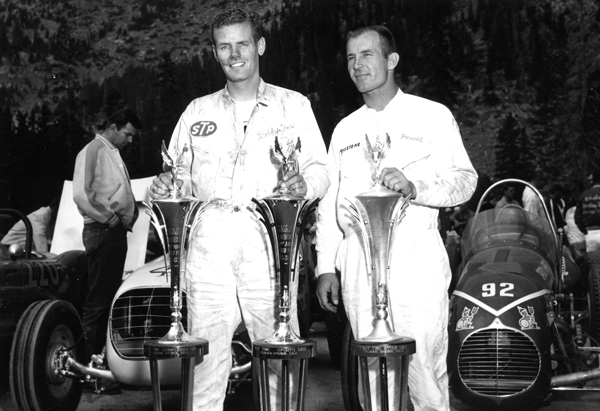 |
|
#3911 - Bobby Unser and Parnelli Jones. In his
memoir, Parnelli wrote, "When it counted, A.J. Foyt had a killer
instinct. So did Mario Andretti and Bobby Unser. Al Unser had it,
too, but not to the same degree that Bobby did. I know I had it,
too. In fact, I’ve still got it. Even playing cards with friends, or
playing a board game, I don't want to get beat. It’s like the old
joke. It’s not that I have to win, it’s just that I can't stand to
lose. You can teach a guy how to get around a track, show him a few
tricks, and get the best out of whatever talent he's got. But you
can’t teach desire. That’s either in somebody, or it’s not." From
As a Matter of Fact, I AM Parnelli Jones, with
Bones Bourcier. (Parnelli Jones Collection) |
|
m |
|
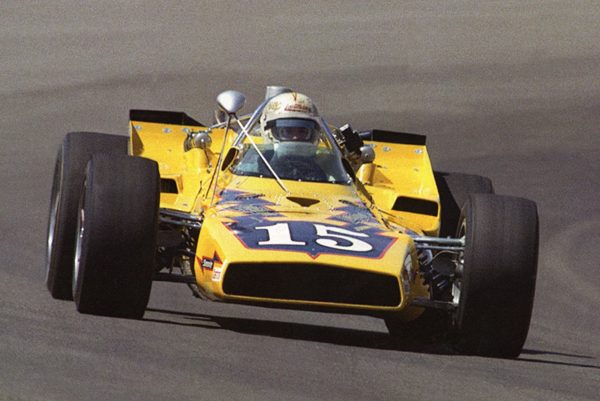 |
|
#3910 - On September 5, 1971 at Ontario Motor
Speedway Steve McQueen added to the traditional opening command:
"Gentlemen start your engines and afterwards cocktails at my place."
Joe Leonard, the ex-motorcycle racer, was likely the first to take
McQueen up on it." His average speed for the 500-mile win in the
Vel's-Parnelli Jones team car was 152.395mph, pulling in $134,347.
From
SEVENTIES CHAMPIONSHIHP REVOLUTION, by Dick Wallen.
(Wallen/Torres Photo) |
|
M |
|
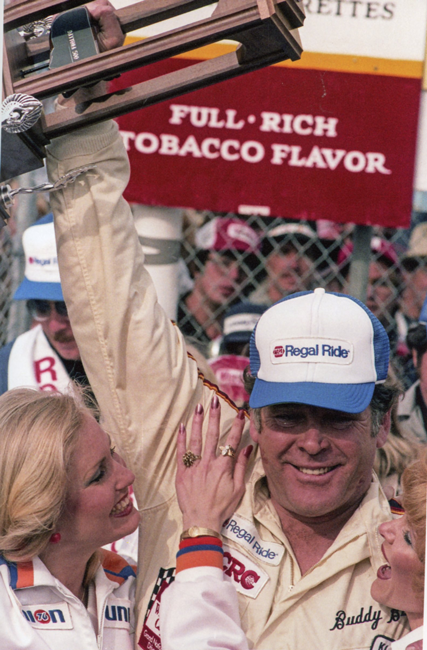 |
#3909 - Buddy Baker was pleased. His winning
speed of 177.602 in the 1980 Daytona 500 remains the fastest ever.
It was his 18th 500 start, "the longest winless drought to start a
career of any Daytona 500 winner until Dale Earnhardt Sr. won in his
20th attempt in 1998." From
HIGH BANKS AND HEROES: 65 Years at Daytona, Home of the Great
American Race, from Daytona Beach News-Journal
|
|
M |
|
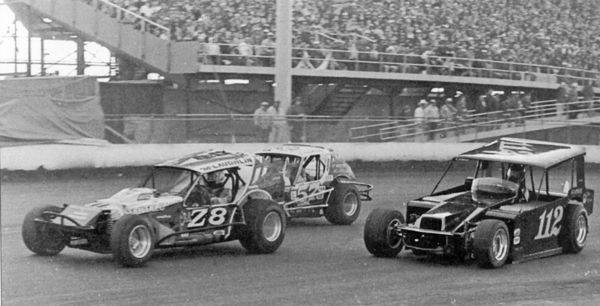 |
|
#3908 - Intensity on the Moody Mile. Mike
McLaughlin (Z8), Tommy Corellis (57), and Gary Balough carry on
during Super DIRT Week 1980. STRAPPED IN magazine 12/19
(Mike Feltenberger Photo) |
|
m |
|
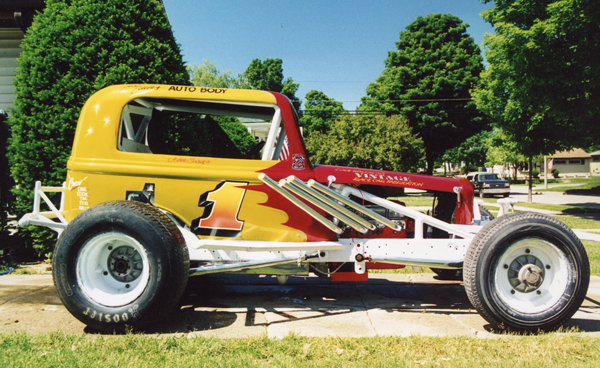 |
|
#3907 - It's so curious that in the 1960s unique
types of race cars developed in certain parts of the country, only
to die off when common configurations became more standard across
the country. The "skeeters" in Georgia, South Carolina, and into
Florida and Alabama were certainly noteworthy, as were the
"Cutdowns," the forebears of the New England Super Modifieds in the
Merrimack Valley of New England. But perhaps of all of them, the
most colorful were the "Milwaukee Modifieds." The racy,
short-wheelbased designs brought enthusiastic crowds to tracks like
Hale's Corners, Cedarburg, Slinger, Beaver Dam, and State Fair Park
between 1959 and the mid-1970s. Clever promoters added distinct
local color by encouraging lead drivers to have nicknames such as
Miles "The Mouse" Melius. (Bradley Poulsen Collection) |
|
M |
|
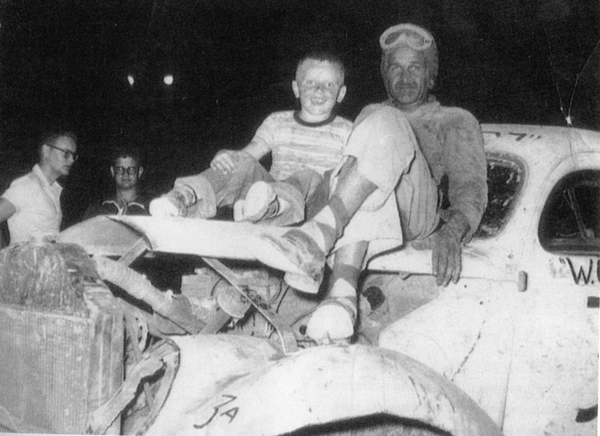 |
#3906 - In 1959 Wendell
Scott eked out the Virginia State Sportsman championship, overcoming
monstrous odds. That's Donnie Drummond sitting with him on the hood.
Donnie's dad, Buck, traveled with Wendell to "protect him from
fights." Photo from HARD DRIVING, The Wendell Scott Story,
by Brian Donovan. (Scott Family Photo)
|
|
m |
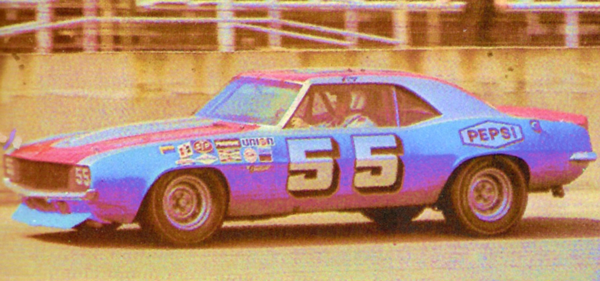 |
|
#3905 - "In 1970 Tiny Lund picked up a Grand
American Pepsi-Cola sponsorship, got a new Camaro, had a new crew
chief by the name of Ronnie Hopkins, which all teamed up to set
records unapproachable for, perhaps, the next hundred years. Lund
peeled off 10 consecutive wins, tying Richard Petty's all-time mark
established in 1967, the year he won 27 GN races." From
UNDENIABLY UNWANTED: Grand Touring and GN East 1968-1973,
by Greg Fielden. (Ray Masser Photo) |
|
m |
|
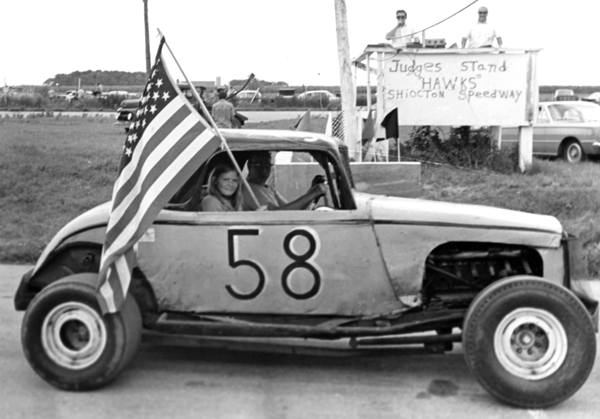 |
|
#3904 - The little quarter-mile in Shiocton,
Wisconsin, was certainly informal, but also, apparently, quite a
lively place. It presented stock cars on Sunday afternoons from 1960
through 1973. A frequent added attraction was a contest to determine
who could author the most remarkable flip down a special embankment.
The winner was awarded a case of beer to soothe any bruises.
(Bradley Poulsen Collection) |
|
M |
|
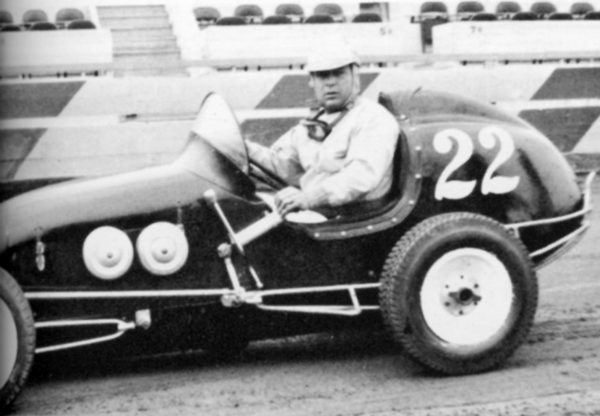 |
|
#3903 - "The 150-mile Midget race on the mile in
Oakland, California, in 1937 ended up in a scoring mix-up which saw
Peewee Distarce flagged as the winner. A few days later a re-check
of the scoring tape revealed that Fred Friday actually won the race.
Gordon Cleveland had blown a tire and crashed over the bank in the
first turn. Some spectators eluded guards and were looking at
Cleveland's wrecked car when Sam Hanks also blew a tire and went
through the hole in the fence made by Cleveland. The spectators
scattered but Hanks' car struck a 16-year-old boy, killing him
instantly and injuring Hanks. As Distarce was driving home, he
struck a drunken farm hand who had staggered out on the highway. The
drunk was killed but Peewee wasn't held. A bad end to a bad
weekend." Quote and Photo from
THE MIGHTY MIDGETS, by Jack C. Fox (Fox Collection) |
|
m |
|
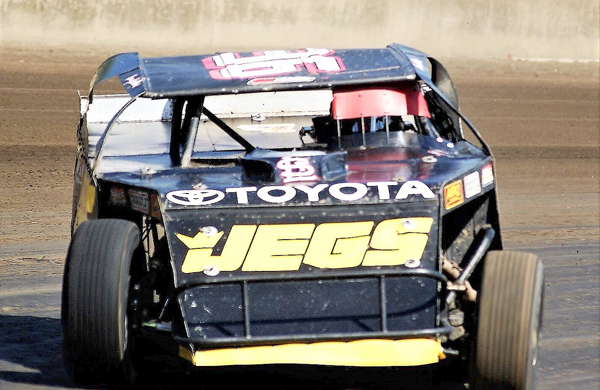 |
|
#3902 - It was a UMP Modified race on the
Springfield Mile in August 2012. Kenny Wallace was on his way to a
third-place finish after a spirited duel with his buddy Ken
Schrader. Still very much at it today, these guys define 'real
racer.' (Mike Feltenberger Photo) |
|
m |
|
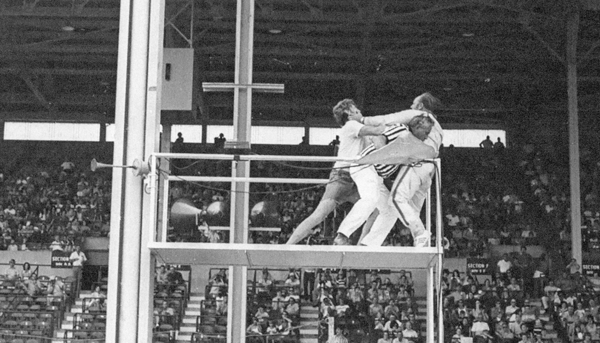 |
#3901 - On July 9, 1972, driver Bill Utz took
some exception to the quality of flagging at a Sprint Car race on
the Du Quoin mile. After several restarts, "including one in which
Utz ran over another car's tire and was done for the day, Utz
ascended the flag stand and made his displeasure known. The
combatants avoided falling off the stand, but reportedly the flagman
had a shiner to wear the following week." From
MORE FAST MEMORIES: Springfield Speedway 1970s -1980s, by
Terry Young and Joyce Standridge. (Young and Standridge Collections)
|
|
m |
|
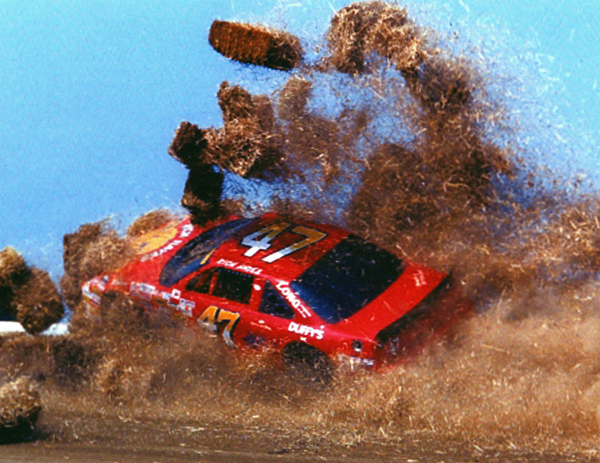 |
|
#3900 - Some years ago, when race tracks were
beginning to consider barriers, the ARCA Racing Series came up with
the idea of installing hay bales in the turns on the Du Quoin mile
before the running of the annual Southern Illinois 100. They didn't
turn out exactly as planned. Rich Hayes found them to be a launching
pad. He landed on all fours outside the track where he watched the
rest of the race. (Photo and caption by Don Figler) |
|
M |
|
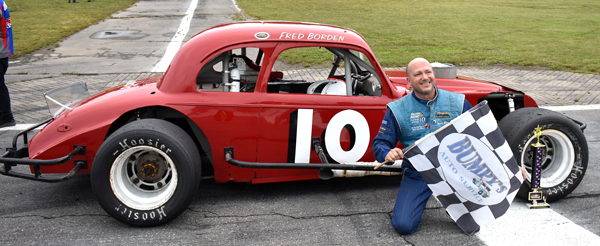 |
|
#3899 - The Falconis of Southboro,
Massachusetts, are one of New England's most respected racing
families. They are known for keeping Westboro Speedway in operation
for three decades and fielding red #10 cars since the days of the
jalopies. Their winners have been Billy Tibbert, Joe Ross, Fred
Borden, Joe Cast, Reino Tulonen, Fats Caruso, Lew Boyd, John Falconi
II and John Falconi III. Just last month Jamie Falconi wheeled this
Fred Borden replica car to victory lane at New Hampshire's Star
Speedway. That brings their family tradition to eight decades.
(Falconi Collection) |
|
m |
|
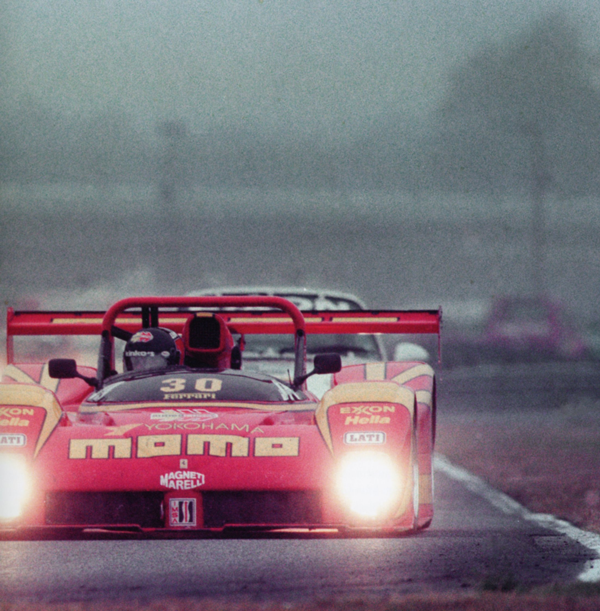 |
|
#3898 - A classic ISMA duel in 1996 in the
morning fog at Daytona. From
ISMA 1990-1996, by Mark and Martin Raffauf. (Brian Cleary
Photo) |
|
M |
|
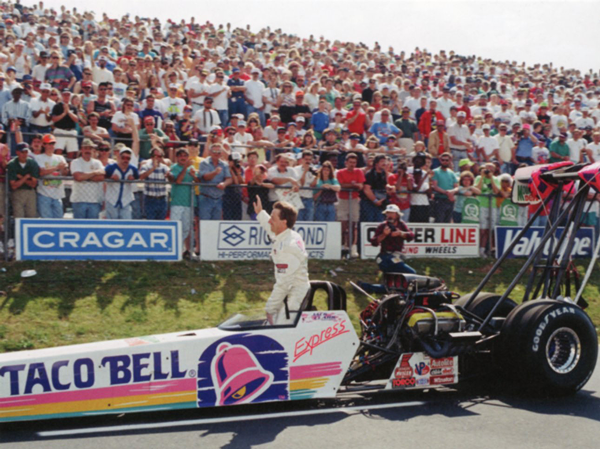 |
|
#3897 The late John Andretti: “Going to the semifinals in my
very first NHRA Top Fuel race in the Taco Bell Express! I loved the
people and the fans in drag racing, but I liked to drive more than
five seconds at a time.” From
JOHN ANDRETTI RACER, as told to Jade Gurss. (Richard Shute
Photo) |
|
m |
|
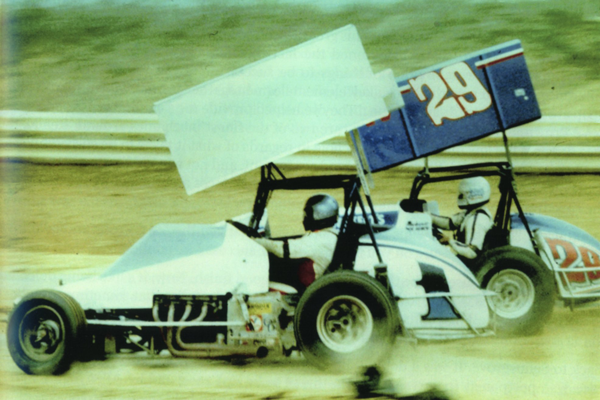 |
|
#3896 - On opening day at Williams Grove, March
30, 1980, Lynn Paxton tried out a brandy-new Lloyd Sprinter with a
Davey Brown big block. It felt good – so good in fact, that he snuck
past Keith Kauffman in the Weikert Livestock car and won the show.
Photo from
LYNN PAXTON: My Way, by Don Robinson. (Paxton Family Photo) |
|
M |
|
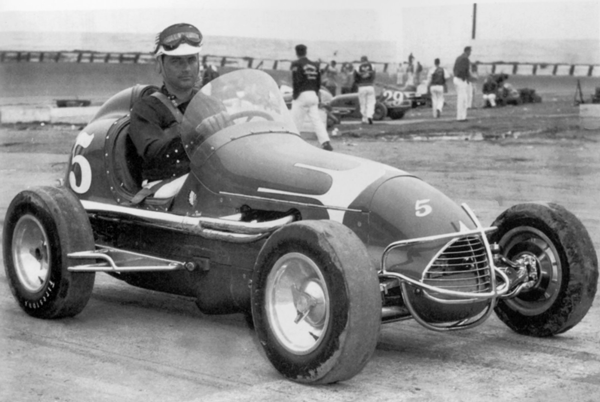 |
#3895 - Fresno's Johnny Boyd was a shining star
in the Midgets with BCRA, URA, AAA, and USAC in the 1950s. His
favorite ride was in Jack London’s Kurtis-Kraft. “Our original plan
was to produce 30 cars," said Frank Kurtis. They went on to pump out
550 between 1948 and 1952. Quote and photo from
KURTIS-KRAFT GENEAOLOGY: Companion Edition, An Illustrated History,
by Bill Montgomery (Jack Fox Photo)
|
|
M |
|
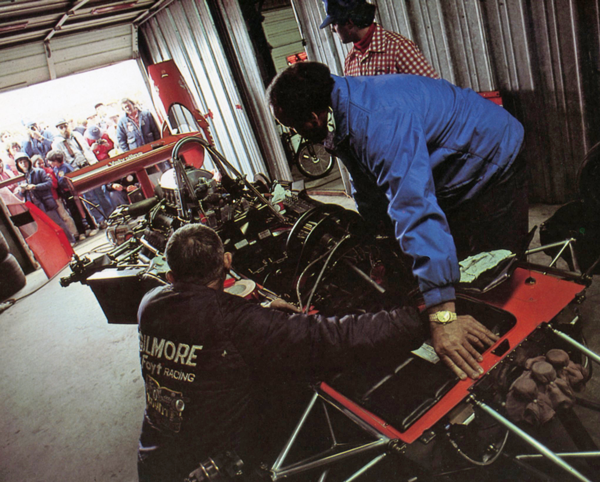 |
|
#3894 - "A.J. Foyt and his long-time engine
builder Howard Gilbert warm up their Cosworth engine while observing
the autograph seekers outside the Pocono garages." Quote and Photo
from SPEED! Indy Car Racing, Photographs by Chet Jezierski. |
|
m |
|
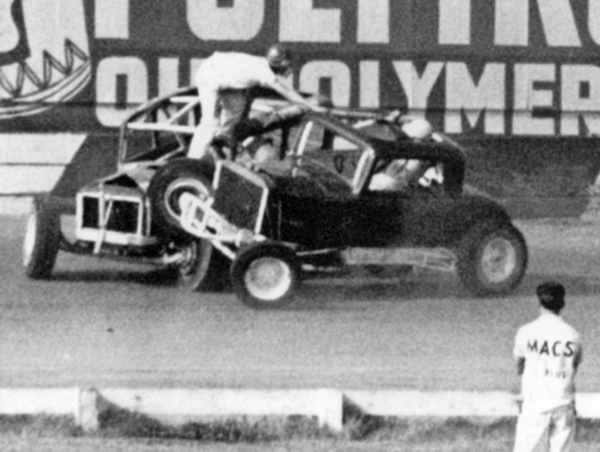 |
|
#3893 - Those jalopy days in California sure
were frisky, and Scotty Cain and Marvin Porter were no small part of
it. Here they gather for some discussion after an on-track
difference of opinion. Photo from RACING’S REAL McCOY, by
Jack McCoy and Keith Sellers. (Montgomery Collection) |
|
M |
|
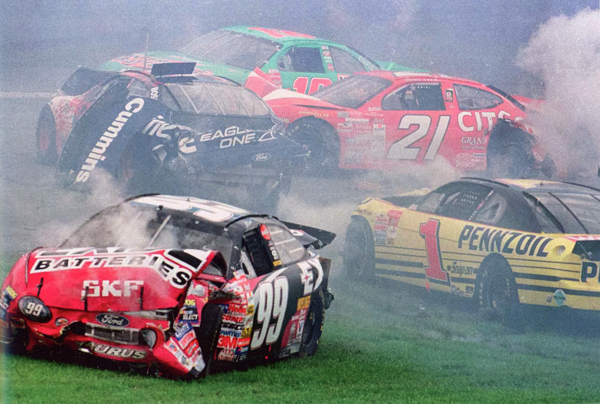 |
|
#3892 - At a quick glance, it looks dreamy, but
it wasn't. It was a wild 13-car crash between turns three and four
in the 1991 Daytona 500. Photo from
HIGH BANKS AND HEROES: 65 Years at Daytona, Home of the Great
American Race, by the editors of the Daytona Beach News
Journal. |
|
m |
|
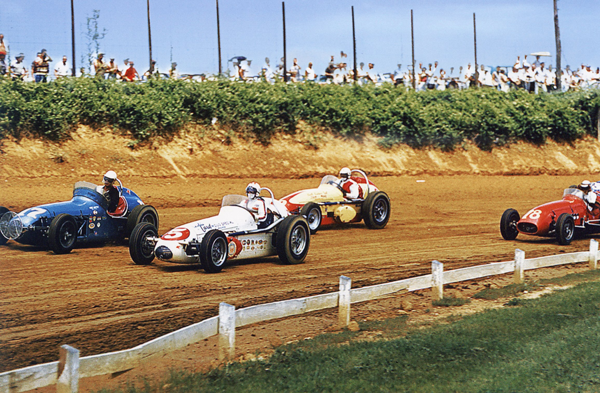 |
|
#3891 - Rodger Ward sat confidently in a Leader Card
dirt car at Williams Grove, PA, in June 1959, and it seemed like it
would be a beautiful day. But it wasn't. The race was halted when
Van Johnson was killed in Jake Vargo's car, the same car Dick Linder
had died in at Trenton in April. Ward kept the lead on the restart,
but the event was halted 14 laps later for rain. Ward made $1275 for
the day. From LEADER
CARD RACERS: A Dynasty of Speed, by Gordon White. (Photo
RMA/Knox) |
|
M |
|
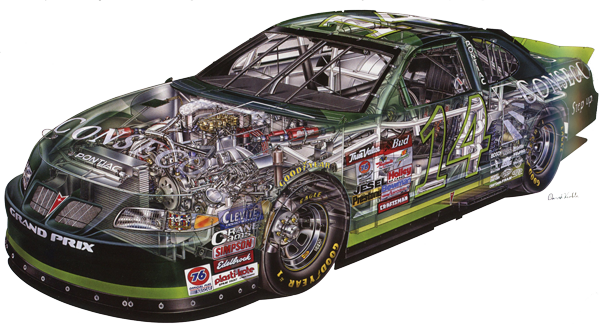 |
|
#3890 -
In 2000, following a four-year absence, A.J. Foyt returned to
Winston Cup in a one-car team run by Waddell Wilson. An advertising
agency hired David Kimble to draw the car, and here's the incredible
cutaway he came up with. From
DAVID KIMBLE’S CUTAWAYS: Techniques & Stories Behind the Art,
by David Kimble.
|
|
m |
|
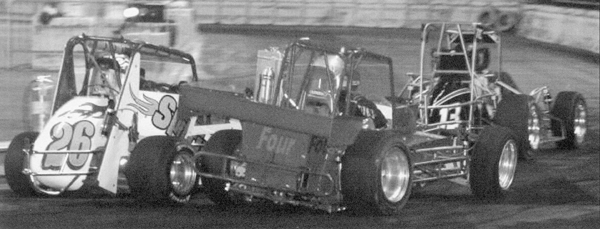 |
|
#3889 - Bet this was fun to watch. Jeff Hoetzler
(4), Joey Payne and Ted Christopher (13) went at it in the closing
laps of the Atlantic City Indoors in 2009. TC prevailed. From
STRAPPED IN magazine, May 2009. (Mike Feltenberger photo.) |
|
M |
|
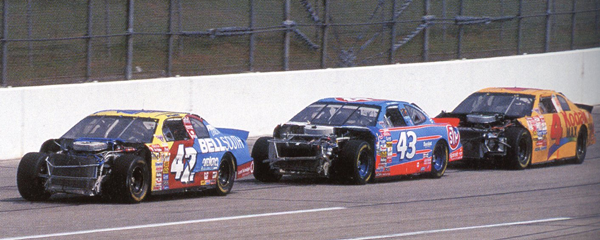 |
|
#3888 - A new aero era? "The battered cars of
#42 Joe Nemechek, #43 John Andretti, and #4 Bobby Hamilton tool
around Talladega Superspeedway at reduced speed after a 20-car crash
in the April 26, 1998 DieHard 500." Photo and Quote from NASCAR:
THE COMPLETE HISTORY, by Greg Fielden. |
|
M |
|
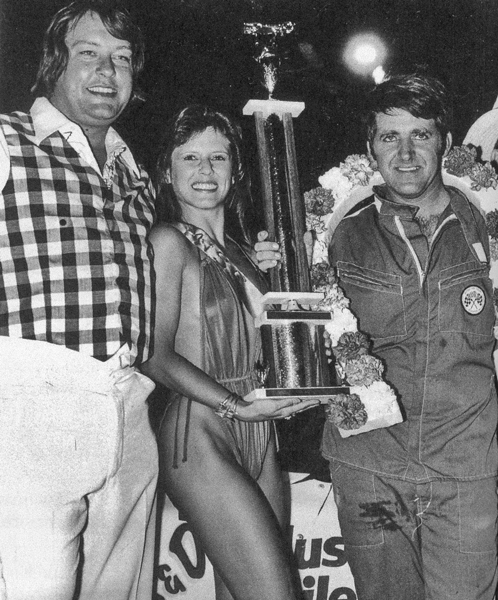 |
|
#3887 - Here’s the "Southern Gentleman" Freddy
Smith celebrating a win at Wythe Raceway on Memorial Day 1980 with
NDRA spark plug Robert Smawley and his perky trophy girl Eva Taylor.
Photo from
THE ROCK-EM. SOCK-EM, TRAVELIN’ DIRT SHOW, by
Gary L. Parker. (Smawley Collection) |
|
m |
|
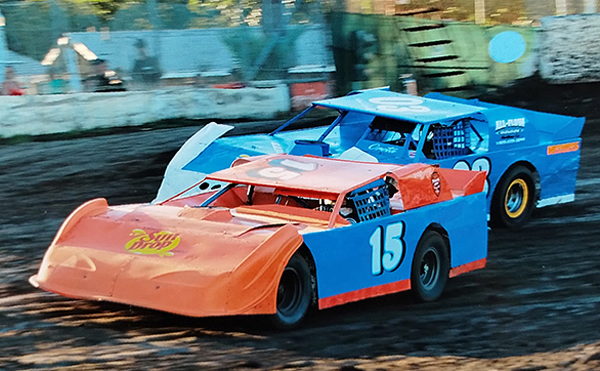 |
#3886 - Popular California racer Larry "The
Sundrop Kid" Damitz started racing Jalopies in 1953 without ever
stopping or winning. Remarkably he won the Antioch (CA) Speedway
Limited Late Model championship in 2010, 2012, 2014, 2015, and 2016.
When he passed away before the season started in 2017, he was 87 and
planning another turn for the title. (Antioch Speedway Collection)
|
|
m |
|
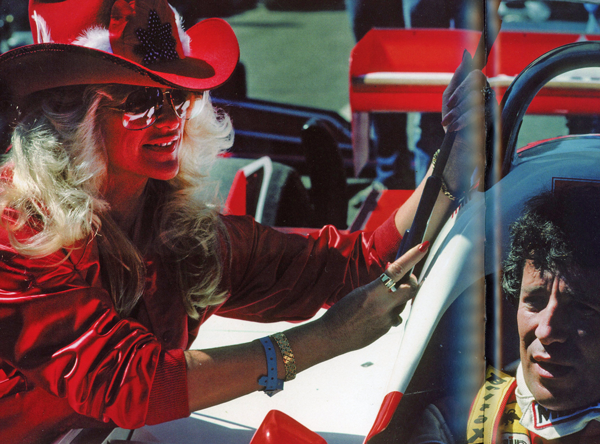 |
|
#3885 - Of her close friendship with Mario,
Linda Vaughn remarked, "During a dinner one day, Niki Lauda said,
'Oh, you're Mario Andretti's mistress.' I answered 'No. I’m his
sister!'" (Quote and photo from Mario Andretti by
Bernard Asset. Bernard Asset Photo) |
|
M |
|
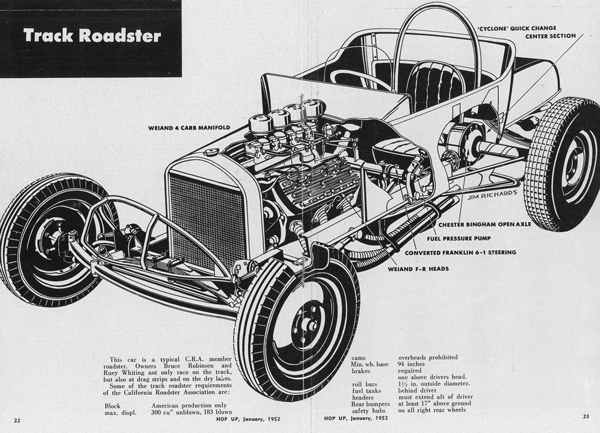 |
|
#3884 - No caption. Credit is Hop Up
magazine, January 1952. |
|
M |
|
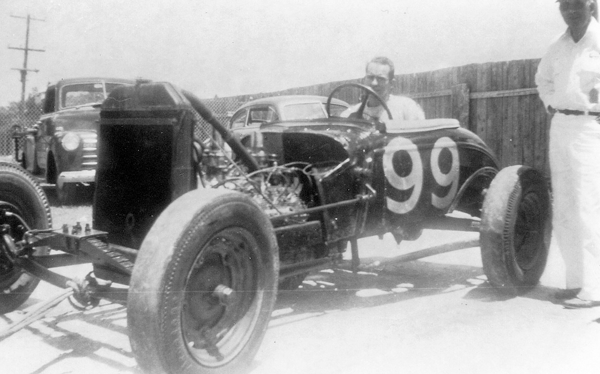 |
#3883 - Floridian Bobby Malzhan spent most of
his successful career on Northern tracks, as did others such as Will
Gagle, Buzzy Reutimann, and Sprint Car ace Bobby Allen. He
campaigned spiffy Modifieds numbered 99 and SSS. Before he left the
Sunshine State, though, his equipment seemed somewhat less
well-conceived. How about that suicide front end, the non-existent
roll bar and wind screen – and that flathead apparently requiring a
reservoir for a radiator. (Brian Sharp Collection)
|
|
M |
|
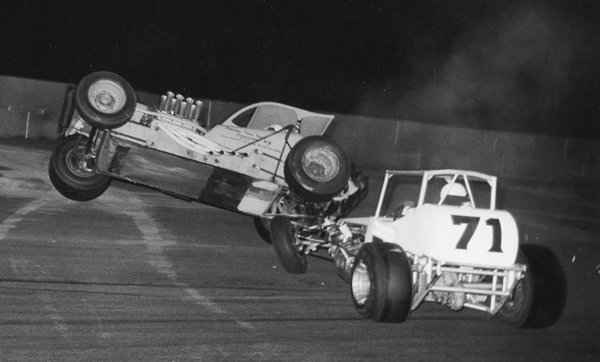 |
|
#3882 - Good guy Neil
"Terrible" Tooley from Evans Mills, NY, was quite the gasser aboard
Supers and Modifieds, especially on the fastest tracks. Little got
in his way, as seen here at Oswego in 1971, when he literally jumped
over Bob Stelter's #71. He stayed upright and motored right on. That
same year, however, a fiery mishap was a bit too much. A dislodged
pipe flew into his car, penetrating his seat and forcing him to
dismount, miraculously uninjured. (Coastal 181 Collection) |
|
m |
|
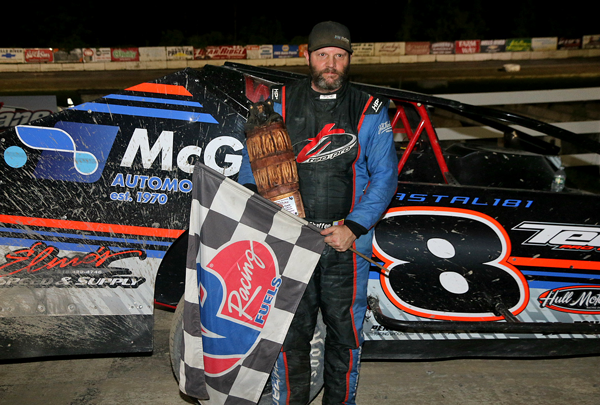 |
|
#3881 - Speedy Kevin Chaffee up there in
Northern Vermont has lots of followers, and I’m one of them. Last
week he pleased all of us with a big win in the Dirt Car Special at
Bear Ridge Speedway. A few winters back, he went down to Florida
quietly to do some racing and he asked to borrow the racing name I
often used, "Finch Fenton." As soon as he did, my phone started
ringing - "How had I gotten so fast in my old age?" (bearridgespeedway.com,
Alan Ward Photo) |
|
m |
|
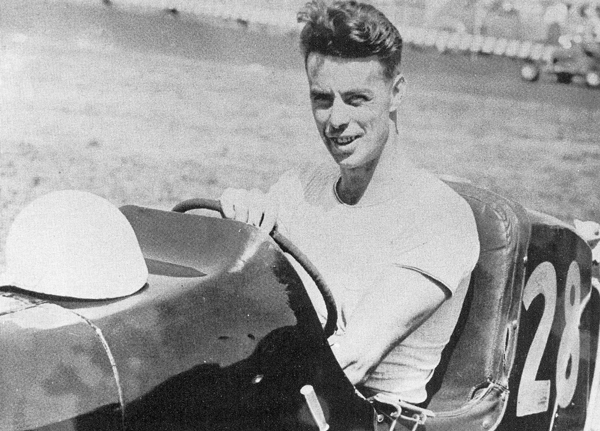 |
|
#3880 - "Ralph Moody. His dad didn't want him to
race - until he found out Ralph was winning." From THE LAST LAP:
The Life and Times and Death of NASCAR’s Legendary Heroes, by
Peter Golenbock (Ralph Moody Collection) |
|
m |
|
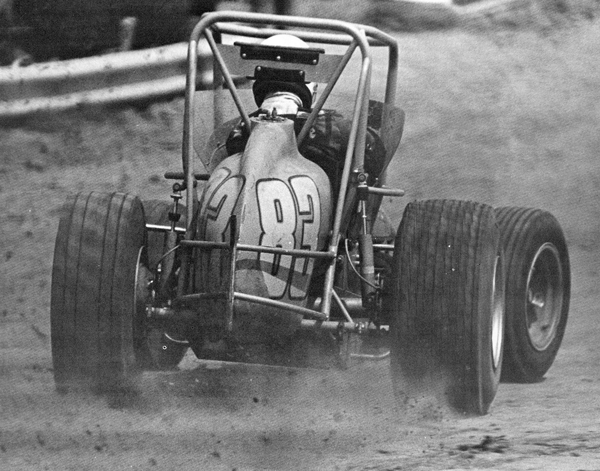 |
|
#3879 - Gary Gray exercises the Gapco Sprinter
through Terre Haute’s fourth turn on September 16, 1980. From
SPRINT CAR PICTORIAL 1980, by Crucean/Mahoney Adventures, Inc. |
|
m |
|
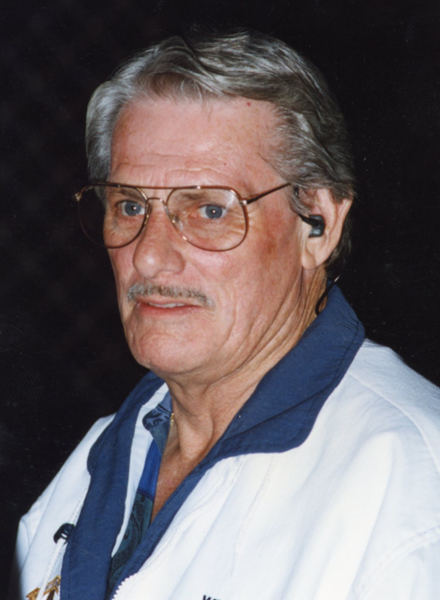 |
|
#3878 - "It took a hard-nosed man to guide the
World of Outlaws through its infancy and into its wild adolescence.
That was Ted Johnson, who founded it and ran it from its debut in
1978 until he sold it to DIRT Motorsports in 2004. Ted tried driving
Midgets as a young man in Wisconsin, but he was a traveling china
salesman when he seized upon the idea of organizing the
coast-to-coast traveling Sprint Car breed." From
SEA TO SHINING SEA: Racing from the Wild West to Daytona,
by Ken Clapp with Bones Bourcier. (Ken Dippel Photo, ProNyne Museum
Collection) |
|
m |
|
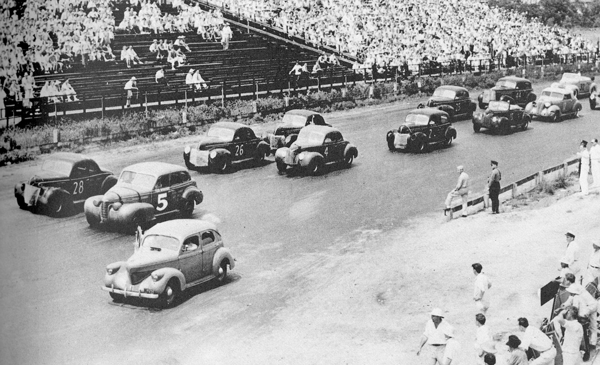 |
|
#3877 - The start of an AAA Stock Car event on
July 4, 1939. Check out the fourth row inside. Can you imagine
driving a pre-war convertible at Langhorne with no roll bar? (Photo
from AMERICAN AUTOMOBILE RACING, by Albert R. Bochroch) |
|
m |
|
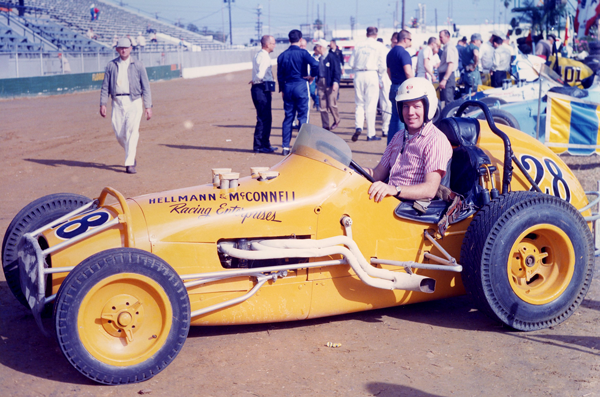 |
|
#3876 - Was there anything that the late will
Cagle drove - and didn’t excel in? Here he was at the Winter Sprint
Car Nationals in Tampa. (Doug Haack Photo, Bradley Poulsen
Collection) |
|
m |
|
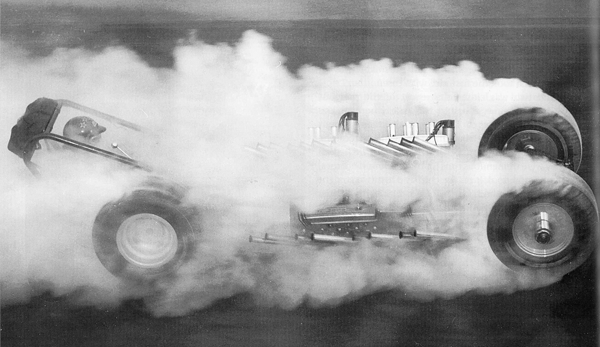 |
|
#3875 - "In 1961, famed
actor and drag racing legend "TV" Tommy Ivo rolled out a creation
that would become one of, if not the, greatest exhibition vehicles
of all time and one that would solidify his standing as the sport's
greatest showman. With four Buick V8 engines strapped to the frame
rails, Ivo's all-wheel drive dragster was a true marvel. The engines
on the left side drove the front wheels through a Halibrand
quick-change center section, while the motors on the right powered
the rear wheels through a second Halibrand situated to the right of
Ivo in the driver's compartment. All told, this monster packed 1,856
cubic inches and made over 2,000 combined horsepower." (Quote from
DRAGZINE.com, photo from
THE HISTORY OF LIONS DRAG STRIP 1955-1972, by Lou Hart,
Lions Automotive Foundation Museum) |
|
m |
|
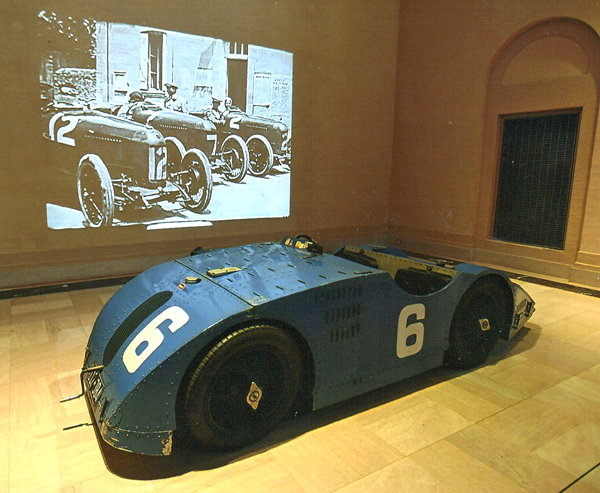 |
#3874 - A recent exhibit at the St. Louis Art
Museum, "Roaring: Art Fashion and the Automobile in France,
1918-1939," featured 12 vintage cars from that era, including six
race cars. Pictured is a 1923 Bugatti Type 32. It was built to
compete in the French Grand Prix of the same year. It was powered by
a 90bhp 2-liter straight-eight engine; take note of the crank at the
nose of the car to start it. It acquired the nickname of "Tank de
Tours" because of its particular shape, which resembles the battle
tanks of its era. During the race, the car reached a top speed of
180km, about 112mph on the straightaway. The car did not handle well
at high speeds because the aerodynamics, a major concern with
today's race cars, were similar to that of a wing profile, which
meant that it would tend to rise at high speeds. However, this car
managed to finish third in the event. (Caption and photo courtesy
Don Figler)
|
|
M |
|
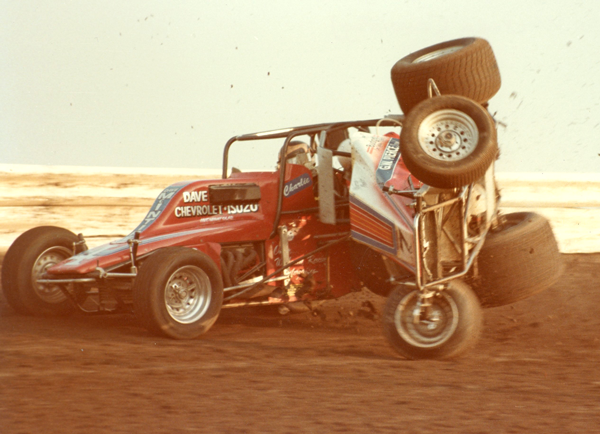 |
|
#3873 - Bob Mays, Midwestern racing historian
par excellence, has seen a ton of racing and has recorded much of
it. Frontline and center in the turn at Granite City, Illinois, on
August 31, 1995 for the USAC Sprints, he was clickin' away when
Warren Mockler launched into a sky ride while Charlie Workman ducked
- and escaped. (Bob Mays Photo) |
|
m |
|
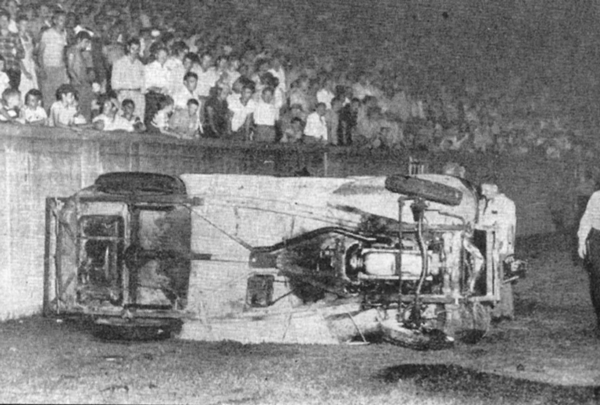 |
|
#3872 - "The origins of
NASCAR's Sportsmen circuit date back to 1949. Bowman-Gray Stadium’s
promoter Alvin Hawkins felt the need to add a division of races to
his weekly Modified and Amateur classification …Hawkins decided to
start a division which was similar to the popular Modifieds, but the
use of expensive parts was not allowed. On the first scheduled race,
Hawkins marveling at the number of contestants…, said 'Can you
believe this field? There ain't no money to speak of, so them boys
certainly must be Sportsmen.' Instantly, it had its name." From
SIZZLING
LATE MODEL SPORTSMAN SERIES: “The Lost Years” – 1977-1981 NASCAR
Late Model Sportsman, by Greg Fielden (Jack Cansler Photo) |
|
M |
|
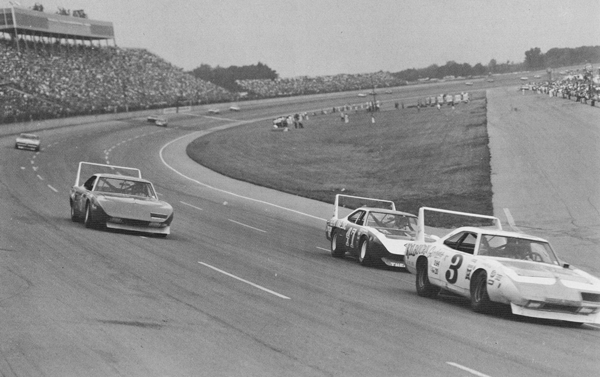 |
|
#3871 - That's Ramo Stott
cruisin' the upstairs on his way to winning the
1972 Michigan 200. He was from Keokuk, Iowa.
Keokuk, seated on the banks of the Mississippi,
launched some of the finest Late Model drivers
in the country - Don White, Ernie Derr, Dick and
Ron Hutchinson, Gordon Blankenship, and Stott,
who won this on a single set of tires. From
FENDERED FURY: The Complete History of USAC
Stock Car Racing, by Bob Mays, Richie
Murray, Pat Sullivan, Steve Zautke. (C.V.
Haschel Photo) |
|
M |
|
 |
|
#3870 - Justin King and Walt
Geis pace the field for the start of a AAA
midget race at the Cincinnati Bowl. The "Cincy'
Bowl" opened in 1948 and ran for a decade. Its
pavement, turns banked to 35 degrees and
straights to 16 degrees, made it one of the
fastest places around. From
KURTIS-KRAFT Midget Genealogy Companion Edition,
An Illustrated History, by Bill
Montgomery. (Dave Knox Photo) |
|
m |
|
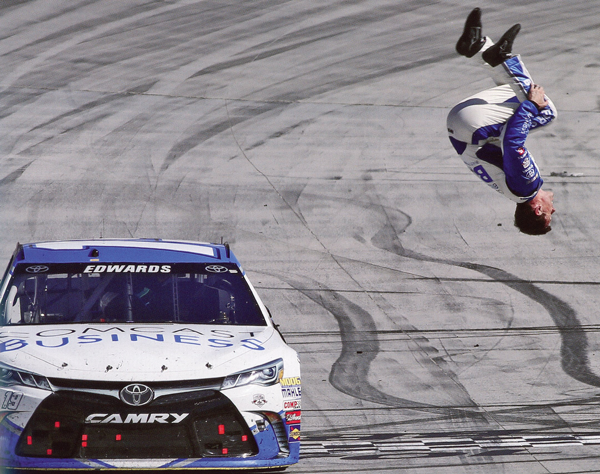 |
|
#3869 - "Carl Edward's
signature move after each of his Cup Series wins
was to climb onto his car and backflip off it
onto the ground. Race fans got to see the stunt
twenty-eight times in his thirteen seasons
before Edwards shocked the NASCAR world by
retiring unexpectedly after the 2016 season,
walking away from the sport entirely without
explanation." Photo and Caption from
NASCAR 75 YEARS, by Kelly Crandall,
Jimmy Creed, Mike Hembree, Al Pierce. (David J
Griffin Photo) |
|
M |
|
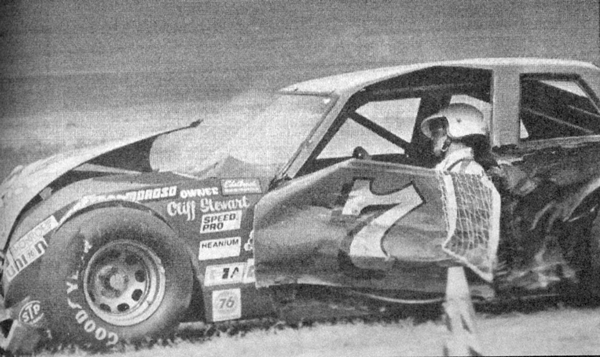 |
|
#3868 - "Morgan Shepherd was
caught up in a big crash in the 1980 Sportsman
300 at Daytona, the season opener for the LMS
circuit. In the mishap Shepherd was knocked out
and is seen here in a motionless state. The car,
which he and his chief mechanic Johnny Townsend
had labored on all winter long, was now a
totaled mess. Shepherd had to borrow rides in
ensuing races and gave up his desire to run for
the title. But in June, when he secured a
sponsor in Hot Rod Barnes, he had some
assistance in preparing a new car and Morgan
found himself still in the point chase. And, in
one if the greatest comebacks stories never
told, Shep won the 1980 LMS championship." From
SIZZLING LATE MODEL SPORTSMAN SERIES: "The Lost
Years" - 1977-1981 NASCAR Late Model Sportsman,
by Greg Fielden. (David Chobat Photo) |
|
m |
|
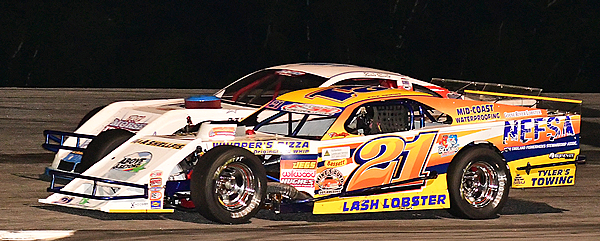 |
|
#3867 - The PASS MODS are a
cost-controlled modified series sanctioned by
the Pro All Stars Series. Here Kyle Hewins #21
and Zach Bowie #6 are side by side for the lead
at Oxford PLains Speedway. Zach and Kyle
currently are the leaders in the MODS points
standings. (Photo by Norm Marx) |
|
M |
|
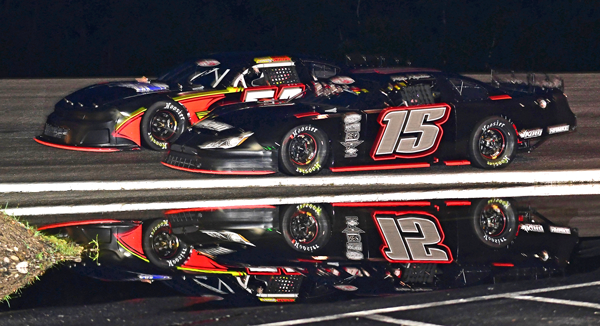 |
|
#3866 - PASS Super Late
Models flash by the puddle in turn four in a 75
lap qualifier for the Celebration of America 300
at Oxford Plains Speedway on Tuesday, July 1st,
2025. In the COA 300 lapper on 7/2 Johnny Clark
in the #54 scored a 4th while Mike Hopkins #15
raced to 6th. (Photo by Norm Marx) |
|
M |
|
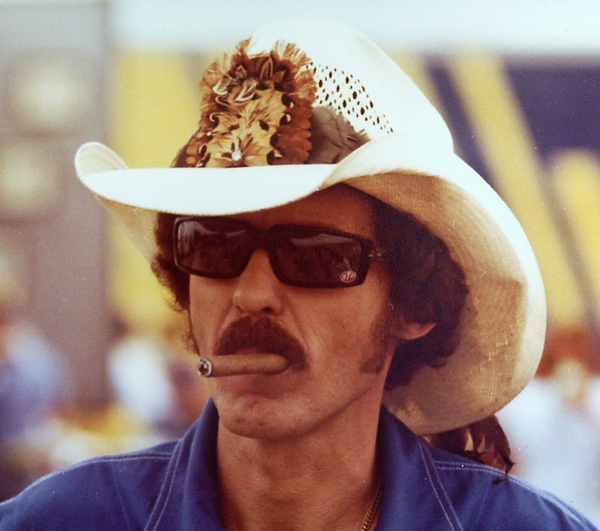 |
|
#3865 - Some days are stones...That was
Richard Petty trying to regroup after a sub-par
qualifying effort for the 1981 Wrangler 400 at
Richmond. He did manage to improve on his 21st
starting spot to finish 11th, but was still five
laps down behind winner Benny Parsons. His
efforts produced $5,660. (Caption and Photo by
Mike Feltenberger) |
|
M |
|
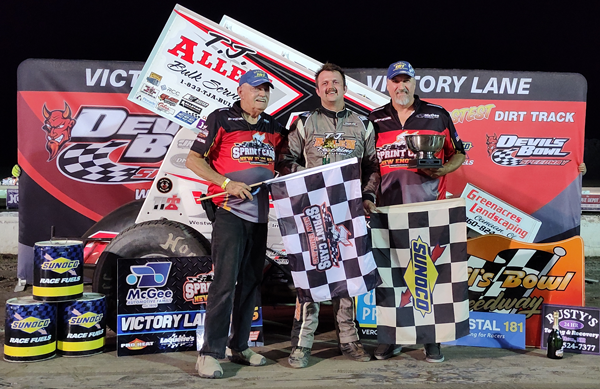 |
|
#3864 - SCONE, the Sprint Cars of New
England circuit, is cookin' with gas these days
under the leadership of Vermont racing
personality Justin St. Louis. Last Saturday they
put on a barn-burner of a feature at Devil's
Bowl Speedway, snatched by a 21-year-old charger
from Fultonville, NY, Chase Moran. He's shown
here receiving the Coastal 181 Cup from SCONE
officials Dennis and Danny Douville. Danny is
himself a two-time SCONE champ. (Justin St.
Louis Photo) |
|
M |
|
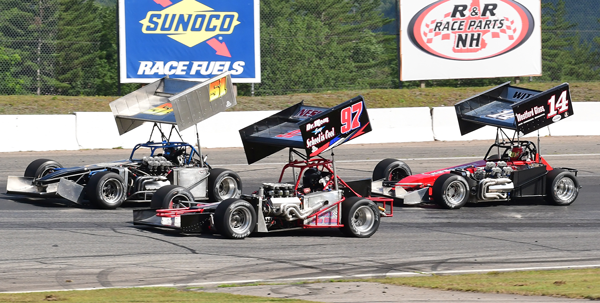 |
|
#3863 - New England
Supermodified Series (NESS) late race action at
White Mountain Motorsports Park on 7/13/25. The
battle for first between Matt Swanson #97 and
Jeffrey Battle #14 tightens up as they maneuver
to pass the #51 of Dave Duggan slowed by a
wounded front wing. Swanson held on to score the
win. (Photo by Norm Marx) |
|
M |
|
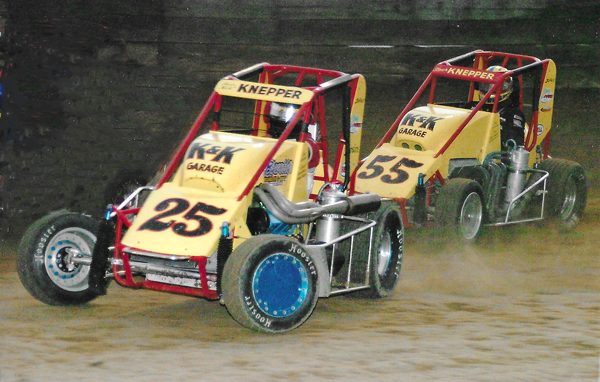 |
|
#3862 - Nick Knepper in the
#25 being chased by his father, Steve, during
the O'Reilly Auto Parts POWRi Series Midget
event at the Belle-Clair Speedway, Belleville,
Illinois, June 10, 2005. Note that infamous
wooden fence looming in the background. (Caption
and photo by Don Figler) |
|
M |
|
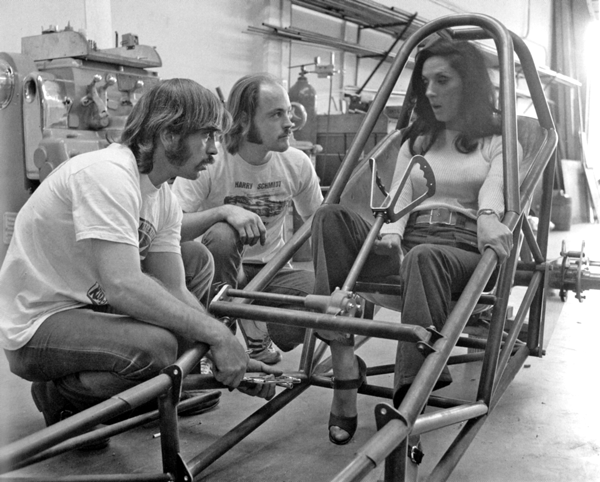 |
|
#3861 - "A rare shot of
three greats in their respective fields. From
left to right: Fabricator Lil' John Buttera,
metal shaper Steve Davis, and driver Shirley
Muldowney. It was 1971, and they were working on
a new car for Shirley at Lil' John's California
shop." From
HOT ROD MAVERICKS: The Builders, Racers, and
Rebels who Revolutionized Hot Rodding,
by Tony Thacker. (Motor Trend Group/Petersen
Automotive Museum Archive Photo) |
|
m |
|
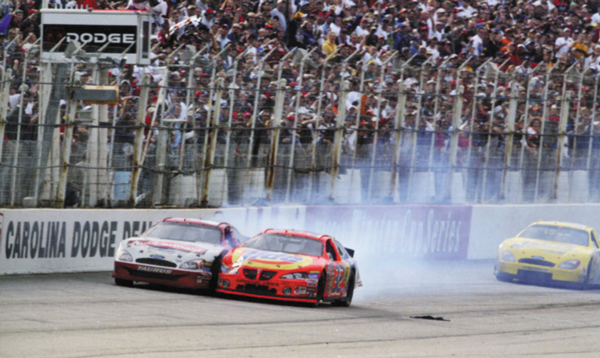 |
|
#3860 - "Kurt Busch (left)
and Ricky Craven race off to the finish of the
2003 Carolina Dodge Dealers 400 on March 16 at
Darlington Raceway. The two traded paint all the
way around the 1.36-mile Raceway during the
final lap, with Craven taking a .002-second
victory in what is still considered the closest
finish in NASCAR history." Quote from
NASCAR 75 YEARS, by Kelly Crandall,
Jimmy Creed, Mike Hembree, Al Pearce. (Nigel
Kinrade Photo) |
|
m |
|
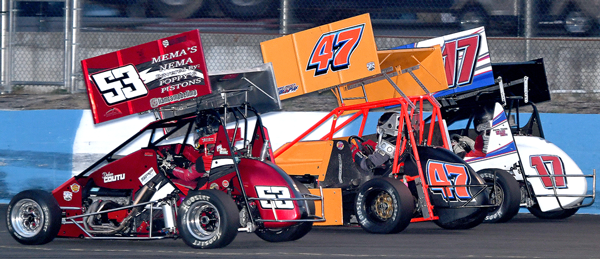 |
|
#3859 - Northeastern Midget
Association (NEMA) LITES Division three-wide
action at New London-Waterford Speedbowl (CT) on
6/28/25. NEMA Photographer John DaDalt peers
into the cockpits of Dylan Coutu #53, Randy
Cabral #47, and Kyle Valeri #17. |
|
m |
|
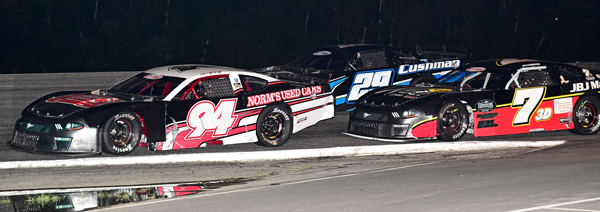 |
|
#3858 - With 5 laps to go
out of 300 in the 7/2/25 PASS Super Late Model
CELEBRATION OF AMERICA 300 at Oxford Plains
Speedway, the hot battle for the lead saw
Garrett Hall #94 holding off Austin Teras #29
and Joey Doiron #73d. Getting the max out of his
older tires, Hall scored his biggest win with
Doiron coming in 2nd. (Photo by Norm Marx) |
|
m |
|
 |
|
#3857 - "In an effort to add
some variety to the Cup series schedule, NASCAR
and the promoters of Bristol Motor Speedway
decided to turn the .533-mile facility into a
dirt track for the spring 2021 race. More than
23,000 cubic yards of dirt were hauled into the
track and put in place so the series could take
place on dirt for the first time since 1970.
Here Ryan Preece (37) kicks up a plume of dust
to pass Cole Custer (41) and Chase Elliott."
From
NASCAR 75 YEARS, by Kelly Crandall,
Jimmy Creed, Mike Hembree, and Al Pierce. (Getty
Images) |
|
m |
|
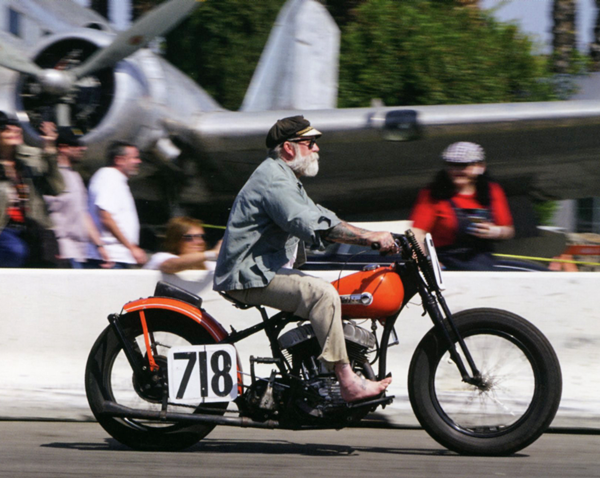 |
#3856 - "In 2012 Mel Stultz
developed an event that changed the global
calendar – The Race of Gentlemen. Here
'barefoot' Mel rides his side-valve
Harley-Davidson against the flow at the
Flabob/Airport/Drags near Riverside California."
Quote and Photo from
HOT ROD MAVERICKS: The Builders, Racers, and
Rebels Who Revolutionized Hot Rodding,
by Tony Thacker. (Tony Thacker Collection)
|
|
M |
|
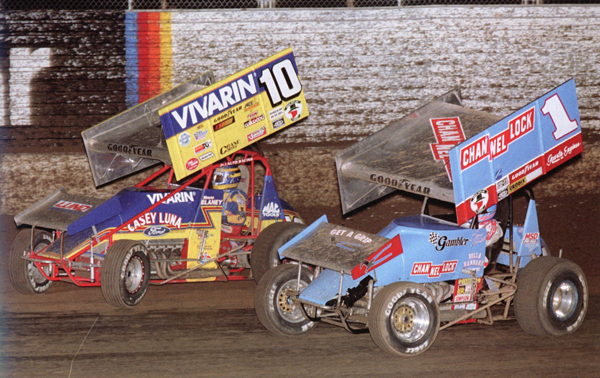 |
|
#3855 - In 1993 Sammy
Swindell had had a slim season, and in 1995 he
concentrated on NASCAR trucks. In 1996 he
regrouped and in 1997 he was ready. He snatched
the first three races of the season, two at
Manzanita and one at Las Vegas on his way to the
title. He's shown here swooping by Dave Blaney
who had quite the push. From
SAMMY! 50+ Years of Winning, by Sammy
Swindell with Bones Bourcier and Bob Mays. (Mike
Arthur Photo) |
|
M |
|
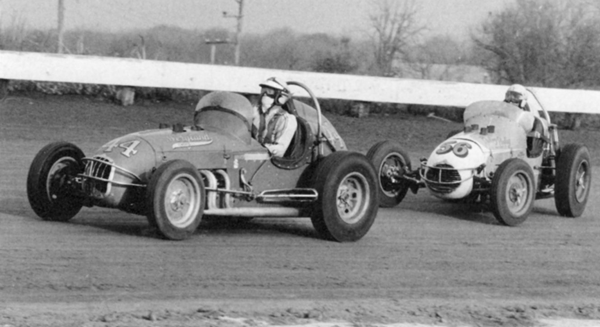 |
|
#3854 - Bobby Marvin (#44) and Jim
Hurtubise dueled at Langhorne on April 7, 1963.
Just a couple of laps later Marvin, substituting
for Jimmy McGuire in the Wergland Sprinter,
caught the fence exiting Puke Hollow, flipped,
and burned. He did not survive. From
LANGHORNE: No Man's Land, by Spencer
Riggs. (Ray Masser Photo) |
|
M |
|
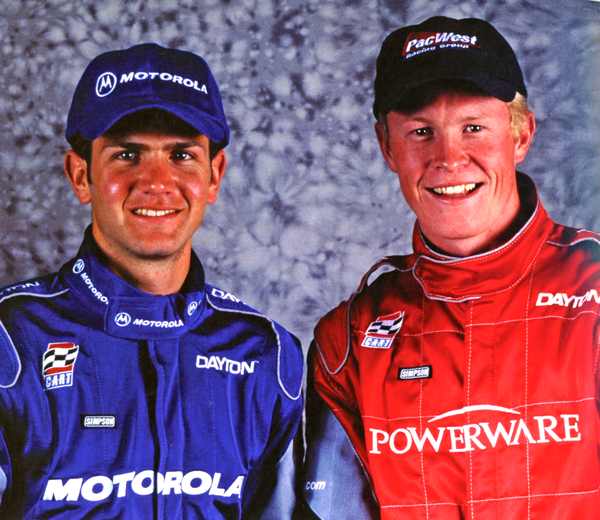 |
|
#3853 - "PacWest's pairing
of Tony Renna and Scott Dixon [check out their
eyes!] in 2000 was arguably among the strongest
in the history of the Indy Lights championship.
Lights team manager Ziggy Harcus added, 'Renna
and Dixon were fantastic friends. That was a
really good year, to me one of the best years
because they were great drivers and great
friends, and it just makes things easier.'" From
TIME FLIES: The History of PacWest Racing,
by John Oreovicz. (Dan R. Boyd Photo) |
|
M |
|
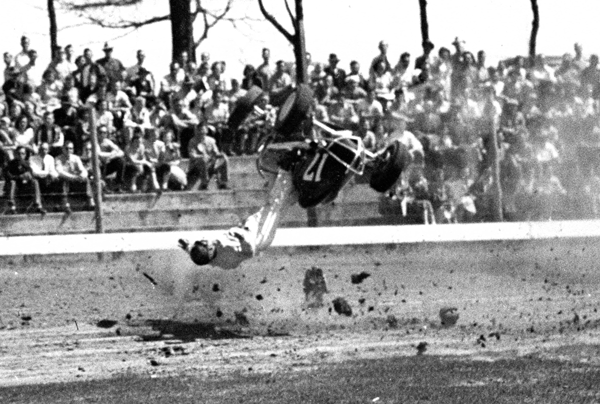 |
|
#3852 - Even though the
1940s boom of the mighty Midgets was softening
somewhat in 1950 with the advent of television –
and the jalopies – things were still pretty
lively in Wisconsin. Milwaukee State Fair Park
drew quite the fields for its AAA shows. Two
features were held on June 10, with California's
Bill Vukovich winning one and Joe Sostillio from
Massachusetts the other. Meanwhile BMARA racing
at Angel Park was eventful, as Al Pavasil proved
with a bit too much hustle. Photo from
Midgets of Wisconsin: An Illustrated
Year-by-Year History of Midget Racing in
America’s Dairyland, by Loren Olson. (Armin
Krueger, Greenfield Gallery Collection) |
|
m |
|
 |
|
#3851 - During the 1967 USAC
visit to Dayton, Ohio, Mike Mosely attempted
this suspended float in his Watson Ford OHC
sprinter. He didn't enjoy a peek at the asphalt,
however. It was a KO. (Photo from AUTO
RACING PHOTO GREATS - Lloyd Masing
Photo) |
|
m |
|
 |
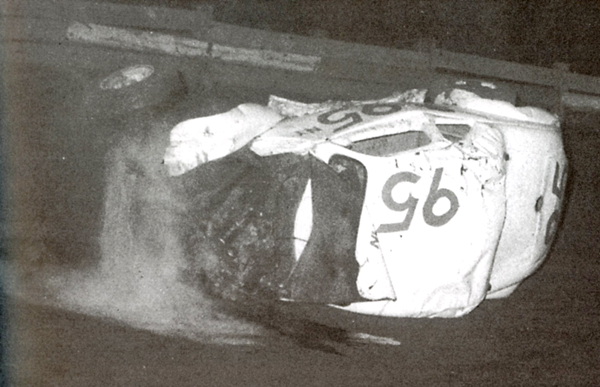 |
|
#3850 - Old-time upstate New
York dirt slinger Kenny Shoemaker was a lot of
action. He's shown here (top) in Catamount, VT,
engaged in conflict resolution, landing one on
frequent competitor Rene Charland. His
relationship with car owners was equally edgy.
Below, he had just flipped with such violence at
Fonda, NY, that when Ted Vogel's #95 finally
landed, it was sans motor and driver. Both had
flown out. "The Shoe’s” comment: 'If a man wants
his car to win, he needs to realize it’s gonna
be wrecked sometimes.'" Photo from Coastal 181's
first book, Kenny’s memoir, THEY CALLED ME
THE SHOE. (Shoemaker Collection) |
|
m |
|
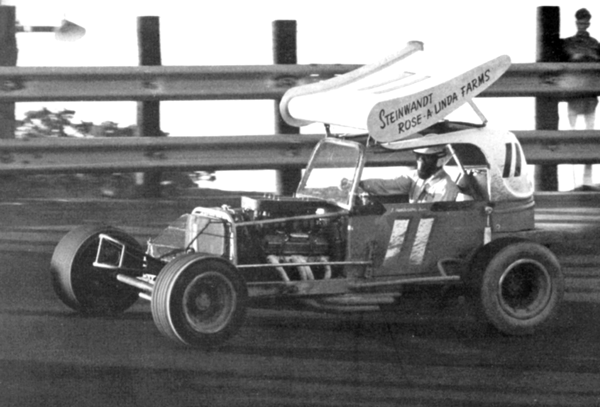 |
#3849 - The rodeo grounds in
Placer County, California, ten miles to the east
of Sacramento, switched to stock cars in 1955,
becoming Roseville Speedway. Here Frank
Henderson cruises the quarter-mile in his early
Super on the first day the facility was paved.
Three years later it was renamed All American
Speedway. It began offering up its annual and
high-paying Roseville Classic 150, later under
NASCAR sanction. From
ALL AMERICAN SPEEDWAY, by Bill
Poindexter. (Henderson Family Collection)
|
|
M |
|
 |
#3848 - Jan Opperman became
a fixture in Bill Smith's 4x. The man sitting on
the trailer is Jerry "Yogi" Janssen, who
discovered Op racing V8-60 Midgets in California
and brought him back to the Midwest. Yogi was a
likeable guy and longtime employee of Speedway
Motors. From
NEBRASKA DIRT: A Century of Racing in the
Cornhusker State, by Bob Mays. (Leroy
Byers Photo)
|
|
M |
|
 |
|
#3847 - Things were always
informal at the old Pines Speedway along the
Merrimack River in Massachusetts. On this night
a bomber lost its way along the backstretch,
flipped over the sand bank, and landed loaded up
on someone's trailer. Sort of. The driver may
have been loaded, too. His seat belt was
attached with a dog leash. From PINES
SPEEDWAY 10th REUNION PROGRAM. (Photo Russ
Conway Collection) |
|
M |
|
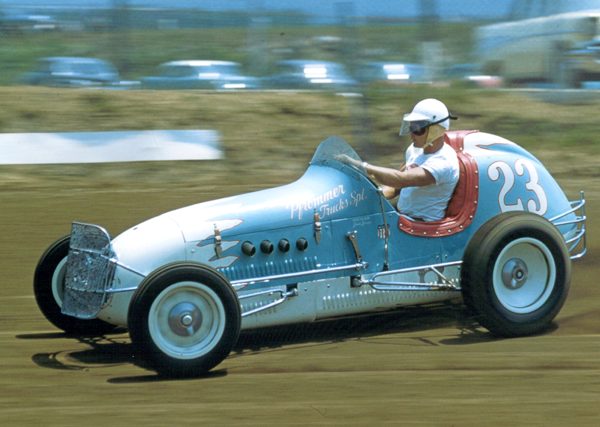 |
#3846 - What would you give
to have seen this? That was Eugene Wesley "Jud"
Larson terrorizing everyone at Reading in 1957
in John Pfrommer's Offy. Larson, the strongman
from Grand Prairie, Texas, barked after passing
his rookie test at Indy in 1952, "There ain't
anything wrong with this joint a little dirt
wouldn’t improve." Quote and Photo from
THE PFROMMER OFFY: A History of an Iconic Sprint
Car, by Alan F. Gross. (Dave Knox
Photo)
|
|
M |
|
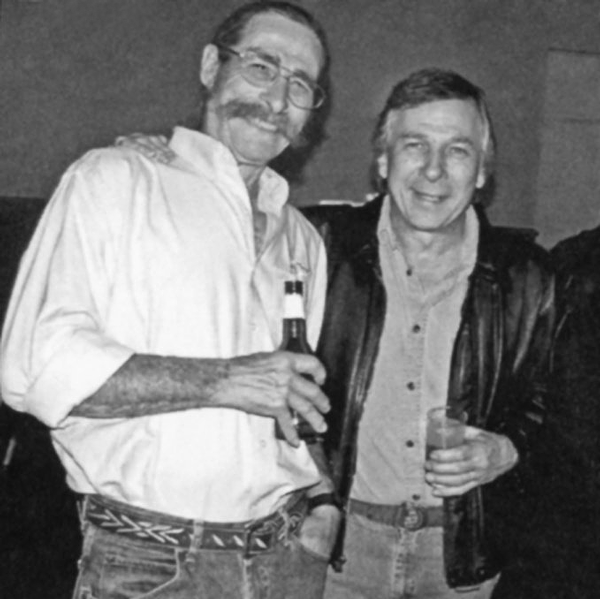 |
|
#3845 - Two seriously
credentialed East Coast Modified standouts,
Kenny Brenn Jr. and Billy Pauch: "I remember one
night (at Flemington, NJ) they battled each
other through the whole feature side-by-side,"
Ken Brenn Sr. called up a memory. "I don’t
remember who won, but the race was so good, they
parked both of them on the start-finish line.
When they interviewed Kenny on the frontstretch,
they asked what the difference was between him
and Billy Pauch. Kenny told ’em, 'He does it for
a living, and I do it for fun.' That was
probably very, very true." Quote and Photo from
THE LAST COWBOY: The Life and Times of Billy
Pauch, by Buffy Swanson. |
|
m |
|
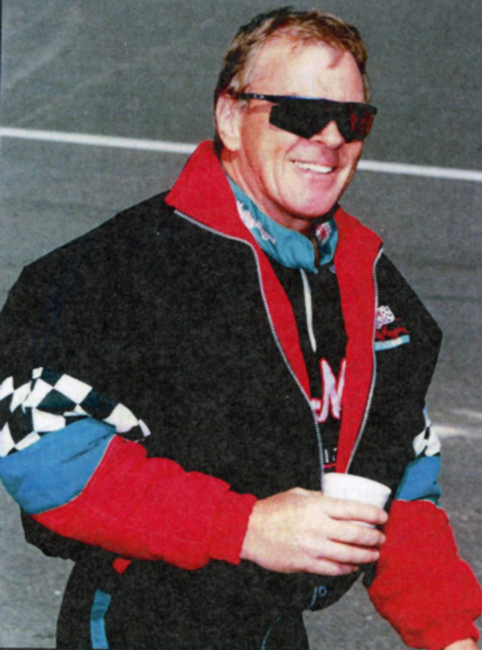 |
|
#3844 - Albert Getzloff, the
late DickTrickle's crew chief, recalls, "He did
some boxing and stuff in high school and years
ago, he really had to horse those cars around
without any power steering. So his arms were big
and he was really, really strong. He didn't have
a lot of motor either in earlier years, so he
really worked on the chassis a lot. He won with
his chassis tuning...Dick was a funny guy and he
loved to have a few laughs. But a lot of that
perception he had was blown out of proportion.
There were a lot of half-drank beers around
there." Quote and Photo from,
WISCONSIN INTERNATIONAL RACEWAY: Where the Big
Ones Run, by Joe Verdegan. (Don Lewis
Photo) |
|
m |
|
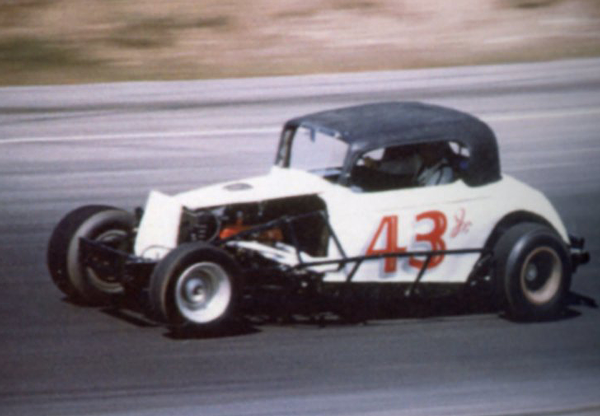 |
|
#3843 - "The late Ted Abbott
is best known as Danbury Connecticut Racearena's
starter, fatally injured at one of the last
races at the track. Abbott was also a flagger at
Plainville (CT) earlier in his career. Less well
known is the fact Abbott occasionally raced a
modified during the early 1970s. This rare image
by Bob Thompson shows Abbott standing on the gas
in turn four at Thomspon Speedway around 1974."
Quote and Photo from
MODIFIED STOCK CAR RACING of the '60s and
'70s, by Steve Kennedy. |
|
M |
|
 |
#3842 - That was the
California Jalopy Association car driven by Don
Edmunds (California's future master builder
extraordinaire) flipping to its demise at
Huntington Beach in 1949. He had already been
ejected through the roof. He ended up with a
broken shoulder blade and $3 for the car from
the junkyard. (Photo from THE DON EDMUNDS
STORY: The Saga of Rotten Red, by Paul
Weisel, Jr.)
|
|
M |
|
 |
|
#3841 - Are you ready? "In 1991 Al
Teague donned his open face and a pair of
goggles and went for 400 mph with just one blown
Chrysler Hemi [at Bonneville. The goal was to
take the Summers Brothers’ wheel-driven record
of 409 set in 1965 with four unblown engines.]
Off the trailer he went 407, but the track was
poor and wet. On the down run he went a
staggering 425.23 with a terminal speed of 432
mph. The turnaround for the return run was
agonizing because of the wet conditions, but
they made it, and Al averaged 409.986 for a new
record." Quote and Photo from
HOT ROD MAVERICKS: The Builders, Racers, and
Rebels Who Revolutionized Hot Rodding,
by Tony Thacker. (Petersen Automotive Museum
Archive) |
|
M |
|
 |
|
#3840 - In the late 1970s,
when Rod Osterlund started his Winston Cup team,
he offered the ride to Dave Byrd, a red-hot
racer in the San Jose area. Byrd thought about
it but declined, favoring to continue his
fabulous Saturday-night career in 30- and
50-lappers for 30 more seasons. Dave Marcis
ended up in the Osterlund seat. Then Dale
Earnhardt. From
SEA TO SHINING SEA, Racing from the Wild West to
California, By Ken Clapp with Bones
Bourcier. (Dennis Mattish Photo) |
|
m |
|
 |
|
#3839 - Our friend Jim Hehl,
the racing historian from Florida, writes, "I
stumbled across this neat photo from 9/8/68 at
the Dayton 500 at Dayton Speedway. That's Benny
Parsons, the race winner, and beside him is
ARCA's most notable champion and ARCA founder
John Marcum. Standing next to John is a young
Phil Parsons, while, just to the right of
Benney's left shoulder peeking across the hood,
is John's young grandson, Ron Drager, who would
become longtime ARCA President." (Jim Hehl
Collection) |
|
M |
|
 |
 |
 |
|
#3838 - Shellhammer’s
Speedway in Leesport, PA, the "Little Track by
the River," runs 25 different classes, many
geared to prepping guys and gals for future
racing endeavors. Here Kassidy Kreitz (69K - now
a 410 Sprint driver) and Dylan Hoch (who became
a multi-feature winner in Sportsman at
Grandview) exercise their Slingshots. Caged
Karts and Wingless Micros are also part of the
action. (Mike Feltenberger photos) |
|
M |
|
 |
|
#3837 - They sure tied them
light at the old Springfield (IL) Speedway, Rick
and Joyce Standridge's home track. No body, no
headers, no shoulder harness. From
FAST MEMORIES: Springfield Speedway 1947-1987,
by Joyce Standridge and Terry Young. |
|
M |
|
 |
#3836 - "Aldo and Mario
Andretti lean in to hear what Foyt has to say
after A.J. led the first ninety-seven laps at
the Hoosier Hundred, only to snap a brake pedal
and finish second. 'I asked him why he was using
his brakes,' Mario recalled. 'I think it pissed
him off.'" From
A.J. FOYT: Survivor, Champion, Legend,
by Art Garner. (Revs Institute, The Bruce R.
Craig Photograph Collection)
|
|
M |
|
 |
#3835 - Growing up on a farm
near Chester, South Carolina, Buck Baker had to
outrun police on his very first whiskey run in
order to stay out of jail. "If there was
something going on that you dare not go to, like
the roughest side of town or the roughest
joints, that's things I played," he told a
reporter shortly before his death in 2002. "I
was brought up like an alley dog. I kind of felt
like I was Buck Baker, a tough somebody. That
may have been because I didn’t have the care of
a mother and father, maybe brothers and sisters.
Maybe I just had a bad outlook on life. I lived
like that for an awful long time, but I never
went to jail in the 1930s.” He started his first
race at 27 in 1946 and became a two-time NASCAR
champ. From THE BEST OF GERALD HODGES,
by Gerald Hodges/the Racing Reporter.
|
|
M |
|
 |
|
#3834 - Things seemed so
much simpler at the Brickyard at the turn of the
1960s. But with visitors like Colin Chapman and
Jimmy Clark in October of 1962, everything was
about to become a lot more complex. Photo from
INDY SPLIT: The Big Money Battle that Nearly
Destroyed Indy Racing, by John
Oreovicz. (IMS Archive Photo) |
|
M |
|
 |
|
#3833 - "As a spokesperson
for Montgomery Ward's Riverside Tires, Sam
(Nunis) taught his bulldog Hank, named for Ralph
Hankinson, to attack Firestone tires as a part
of his 'Pit Lane Medicine Show.' Little Hank is
seen here biting the tread of a competitor's
rear Firestone tire." Quote and photo from
The Miller Grill, a historical
novel by Bart Stevens. (Nunis Family Collection) |
|
m |
|
 |
|
#3832 - It was twelve to go
at Turkey Night at Ventura, California, in 2018,
and two young guys, Kyle Larson and Christopher
Bell, were playing rabbit and hound on steroids.
Bell won it. "I just got lucky being there in
second. Someone was making the bottom work
beneath me in three and four, and I figured it
was going to get better and better. I trapped
Kyle up there with a lapped car." Quote and
photo from
TURKEY NIGHT: Midget Racing at Thanksgiving
-
Race by Race 1934 - 2024,
by Dave Wolin. (Racer magazine photo) |
|
m |
|
 |
|
#3831 - Dick Berggren went
to the recent Vintage Drags show at Oxford Pains
up in Maine. "This was my favorite. Six chrome
carbs and no fenders." (Dick Berggren Photo) |
|
m |
|
 |
|
#3830 - From talented lensman John
DaDalt: "I've been in Indy for the past week,
and here's a shot of Jake Trainor in the Seymour
#29 sprint car at Anderson
Speedway. Jake had quite a weekend, winning the
All-Star midget feature at Indianapolis Raceway
Park Friday night. Then, even more impressively,
he went from 16th to 5th in the "Hoosier
Hundred" USAC Silver Crown race, also at IRP. It
was only his second career start in the ‘big
cars.’ Then he and the Seymour guys topped it
off with a win in the Little 500 on Saturday
night at Anderson.” (John DaDalt Photo) |
|
m |
|
 |
|
#3829 - That's Donnie
Beechler in the 1950 Indy 500 winning car of Johnnie
Parsons. He's all set because Bones Bourcier
leaned in and told him to take it right to the
cushion. |
|
M |
|
 |
|
#3828 - In 1948 21-year-old
Eddie Sachs moved to Greensboro to compete in
Bill France's formative NASCAR events. By 1961
he had become racing's "Clown Prince" and came
within three laps of winning the Indy 500.
(Photo from
REBELS WITHOUT APPLAUSE: Southern Late Model
Racing 1938-1949, by Greg Fielden.
(Walter Chernokal Photo) |
|
m |
|
 |
|
#3827 - Rick Mears. "The
fans know we are running at 200mph, but they do
not know what that means...I usually put it that
we are covering a football field in a second.
And that kind of gives them an idea, because
they know what a football field looks like. When
they’re up in the stands watching from a
distance, the cars don't look like they are
really running that fast. Another thing is the
reason people like stock cars so much; they can
run close. Fans don’t realize it, but we can't
run close. That’s when we get in trouble, 'cause
our cars depend on the air for downforce. When
we get close to somebody, the wings 'go away.'
The cars won’t handle." Photo and Quote from
SPEED! Indy Car Racing, Photographs by Chet
Jezierski. |
|
mm |
|
 |
|
#3826 - It was Brightbill
and Horton at an open-comp show at Bridgeport,
NJ. No question that Kenny got into his work.
(Mike Feltenberger photo, STRAPPED IN magazine) |
|
M |
|
 |
|
#3825 - Perhaps the most
celebrated Californian Sprint Car driver of all
time, Bent Kaeding is the second in three
generations of family racers. He may have won
some 400 features, but "the things that stick
out to me the most are the pre-race and
post-race activities like the pancake
breakfasts, racing during the fairs, and
drinking out on the pavilion until the sun came
up." (Quote from
Rustmag.com,
Saroyan Humphrey Photo) |
|
M |
|
 |
|
#3824 - Fan favorite George
"Ziggy" Snider, shown with legendary mechanic
A.J. Watson. Starting back in 1965, quite
remarkably, the Californian had 22 starts at the
Brickyard, more than anyone else without winning
the race. His eighth place in 1975 was his best
finish. He was frequently aboard his buddy A.J.
Foyt's entry. Photo from
SEA TO SHINING SEA: Racing From the Wild West to
Daytona, by Ken Clapp with Bones
Bourcier (John Isom Photo) |
|
M |
|
 |
 |
|
#3823 - When it was opened, Maine's Oxford Plains Speedway
was one primitive place. That was long before Bob Bahre bought it
and turned it into a shining facility hosting the nationally
recognized Oxford 250 for Super Late Models. Here's some of racer
Roland Brown's summer back in 1950. The crowds loved it and were
huge. (Photos from Oxford Plains Speedway: The First Three Years
1950-1952, by Floyd E. "Zeke" Trask) |
|
M |
|
 |
|
#3822 - Chaos at Eldora in 2007. Dave Darland,
Brady Short, Mike Brecht, and Darren Hagen in crunchy company. From
MODERN THUNDER: The Illustrated History of USAC National Sprint Car
Racing 1983-2019, by Dave Argabright, John Mahoney, and
Patrick Sullivan. (John Mahoney Photo) |
|
M |
|
 |
|
#3821 - "Poughkeepsie-based Dyson Racing had
many of the same crew members working together over the years, which
was one of the reasons behind its success....Rob Dyson's victory
total in IMSA Prototypes was unsurpassed." Quote and photo from
IMSA 1990-1999: The Turbulent Years of American Sports Car Racing,
by Mark Raffauf. (Rick Dole Photo) |
|
m |
|
 |
|
#3820 - "As if his [Chevy/Harley] contraption
wasn't crazy enough, E.J Potter would rev the bike up on the rear
stand before rocking it off and rocketing up the asphalt in
spectacular, smokey, crowd-pleasing fashion. For this he was
typically paid $1 per mile per hour over 100 mph. He eventually got
the 'Widowmaker' up to 160 mph." From
HOT ROD MAVERICKS: The Builders, Racers, and Rebels Who
Revolutionized Hot Rodding, by Tony Thacker. (Motor Trend
Group/Petersen Automotive Museum Archive) |
|
m |
|
 |
|
#3819 - Sammy Swindell had just scored $27,000
from the Syracuse SuperNationals and then it was $65,000 at North
Texas Speedway from some noticeably pleasing attendants. He managed
half a smile. From
SAMMY: 50+ Years of Winning, as told to Bones Bourcier.
(Paul Arch Photo) |
|
m |
|
 |
|
#3818 - When core crewman Mike Hayslett read the
draft of "Barefoot Bob" McCreadie’s book, he commented, "I like what
Bob has to say in this chapter. I don't think Brett (Hearne's) gonna
like it. But, hey, in a couple of years, Brett can have his own book
and get even." From BAREFOOT: The Autobiography of Bob McCreadie,
as told to Andy Fusco. |
|
M |
|
 |
|
#3817 - It was May of 1973, and Bentley Warren
was doing his best at Indy in his undernourished, five-year-old
Eagle. He commented, "I'll tell you how outclassed we were in
relation to the top cars. To adjust the boost on those Offy engines,
you had to loosen a lock nut and turn a bolt on the waste gate. We
were so afraid of blowing up our engine that we'd add boost a tiny
bit at a time, maybe three-quarters of a turn on that bolt. Well, I
watched Bobby Unser's team add boost in the qualifying line. Their
engine man loosened the lock nut, put a speed wrench on that bolt,
and just cranked away. My eyes must have been as big as watermelons.
I could not believe what I was seeing. Big boost means big speed.
Bobby broke the track record by nearly 18 miles per hour. Most of
that was due to his sleek Eagle, but the engine didn't hurt." From
WICKED FAST: Racing Through Life with Bentley Warren, as
told to Bones Bourcier. (IMS Archive Photo) |
|
M |
|
 |
|
#3816 - Bob Potter at Connecticut's New London
Waterford Speedbowl: "I remember one time I was leading a race down
the Speedbowl years ago. They had a wreck and they threw the red
flag. You could get out of your car, so me and my buddy, we're both
outside our cars shooting the breeze. I started laughing... 'It
sounds like somebody's tire going down.' Come to find out it was my
right rear... So my buddy, Jerry Glaude, he chews gum, so I says,
'Got any gum?...I took the gum, put it on that hole - you could see
it, it was small. We backed the car up so we set right it on the
gum. And it didn’t leak no more. I could finish the race and ended
up winning!" Quote and Photo from
MODIFIED STOCK CAR RACING of the ’60s and ’70s, by Steve
Kennedy. (Steve Kennedy Photo) |
|
M |
|
 |
|
#3815 - Martinsville November 2022. "Ross
Chastain came up with what is now called 'Hail Melon' - a nod to his
family’s watermelon farming business - by jamming his Chevrolet into
the wall and simultaneously mashing the gas. That combo enabled the
Chevy to turn a lap faster than the track's pole qualifying record.
Chastain made up five spots to make the final four." Quote and Photo
from
NASCAR MAVERICKS, by H. A. Branham and Holly Cain. (Stacey
Revere/Getty Images) |
|
m |
|
 |
|
#3814 - "Having witnessed several veteran
drivers be killed or badly injured in fiery racing accidents, Len
[Sutton] decided to hang up his helmet in the middle of the 1965
season. He went on to work for several racing equipment companies
and to be a radio announcer at the Indy 500 for several years. As in
the case of many great racers, Len's failure to win the Indy 500
doomed this highly talented and accomplished man to undeserved
obscurity." Quote and Photo from
SECOND TO ONE: All but for INDY, by Joe Freeman and Gordon
Kirby (RMA/Knox Photo) |
|
M |
|
 |
|
#3813 - Rick Standridge's most impressive
fly-over at Illinois' Shepp's Speedway in 2008. His wife, Joyce,
said, "Rick had a broken sternum and broken ribs. He (and I) spent
the night at St. John's Hospital in Springfield (IL) but not for
those injuries. The nurses couldn't get his asthma under control."
Quote and Photo from
FOUR AND MORE: The Standridge Brothers – Big Wins, Big Wrecks, Big
Fun, by Joyce Standridge. (Jim Jones, Double J Photo) |
|
m |
|
 |
#3812 - A very rare image of the horrendous
inferno at the first National Open at Langhorne in 1951. "Wreckage
from Don Black's car is strewn across the track, with Wally
Campbell's machine (far right) in flames. Dick Linder's V2 is
involved with several other cars partially obscured by smoke.
Miraculously, only Black was seriously injured in the fiery
accident." Caption and photo from
LANGHORNE No Man’s Land, by Spencer Riggs. (Photo Theresa
Campbell Collection)
|
|
M |
|
 |
|
#3811 - We were very sorry to lose our friend,
the great Ed Pink this week. Coaxed on by his buddy Jim Busby, Ed
entered the sports car world in 1986 reworking Porsche factory
engines. Ed would later comment, "I don’t know if 'haul ass'
translates directly into German. But that’s what we did." Quote and
photo from
ED PINK: The Old Master, by Ed Pink with Bones Bourcier.
(Ed Pink Collection) |
|
M |
|
 |
|
#3810 - The much-admired Jimmy Caruthers, 1975
USAC Midget Champion, pictured here posing with his
championship-winning Pizza Hut Silver Crown car and his crew. From
left to right, Skip Wiese, owner and sponsor George Middleton, Walt
Krueger, Wayne Lee, Joe Johnson, and Chief Mechanic Larry Griffiths.
Jimmy competed in the 1975 USAC Silver Crown season while suffering
from cancer and managed a third place in the last race in September
during the Hoosier 100. It earned him the championship. Sadly, he
passed away six weeks later at the age of 30. (Photo and a caption
by Don Figler) |
|
m |
|
 |
#3808 - The Nutley (NJ) Veladrome was built for
bicycle racing in 1933. It was something to behold – a 1/7-mile
boarded oval saucer banked at an incredible 45 degrees, seating
12,000. When interest in the two-wheelers declined, into town came
the AAA Midgets in 1938, offering up insanely dangerous, high-octane
spectacles. Here Duane Carter and Paul Russo test destiny. After
three fatalities in two years, county voters shut it all down.
(Photo from HARD DRIVING MEN: Images of Speed 1895-1960, by
Dick Wallen. (Dick Wallen Collection)
|
|
m |
|
 |
|
#3807 - Oh My! (Photo from Speedway Illustrated May 2025) |
|
M |
|
 |
|
#3806 - "Since 1974, Goodyear's wet-weather
tyres have enabled drivers to lap at very high speeds, even when
tracks are soaking wet. At practice at Monaco, Emerson Fittipaldi
put Goodyear "wets" through their paces." Quote and photo from
Autocourse 1977, Mike Kettewell, editor. (Richard Poulter
Photo) |
|
M |
|
 |
|
#3804 - "January 11, 1937, and they were
preparing and fueling George Eyston's Thunderbolt for another
attempt at the land speed record. He eventually set the record at
357.5 in 1938." From
HOT ROD MAVERICKS: The Builders, Racers, and Rebels who
Revolutionized Hot Rodding, by Tony Thacker. (Keystone
France Photo) |
|
M |
|
 |
|
#3803 - Ray Spognardi, Richie Evans' friend and
crewman: "I saw what Richie did at Daytona. He adapted to that place
so fast it was scary. We’d get there, and before he'd go out for
first warmups he’d be as nervous as anyone else. I mean, it’s
Daytona. His temples would be twitching. He'd go out for a few laps,
and when he got back in, he’d still be the same way, high-strung.
But after he went out the second time, he’d be as relaxed as if we
were running at some half mile. That used to amaze me." Quote and
Photo from
RICHIE: The Fast Life and Times of NASCAR’s Greatest Modified Driver,
by Bones Bourcier. (Ray's Racing Photo, Lynn Evans Collection) |
|
m |
|
 |
 |
|
#3802 - Mario and Michael. From MARIO
ANDRETTI, by Bernard Asset. (Bernard Asset Photos) |
|
m |
|
 |
|
#3801 - Dario Franchitti: "The most telling
endorsement of Dan Gurney comes from the funeral of his sparring
partner Jim Clark in 1988. Jim’s father took him to one side and
confided to him that he was the only driver his son feared on the
track." Quote and Photo from ROMANCE OF RACING, by Dario
Franchitti. (Bernard Cahier Photo) |
|
 All Previous
Photos of the Day HERE
All Previous
Photos of the Day HERE |
|